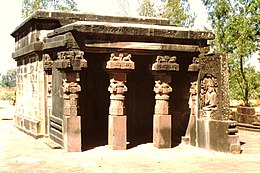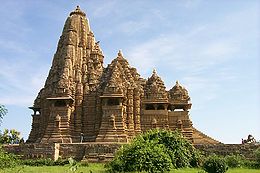Temple
![]()
The title of this article is ambiguous. For other meanings, see Temple (disambiguation).
Temple (from Latin templum) is the German designation for buildings that have served as sanctuaries in many religions since the Neolithic. The oldest buildings to which the designation is directly applied are the temples of Göbekli Tepe (from about 9600 BC) and the Maltese temples (from 3800 BC).
From the basic meaning of the word, Latin templum (in Etruscan and Roman religion) is at first nothing else than a district separated from the realm of the profane, in which augurs exercised the observation and interpretation of the flight of birds and other signs. In ancient Greek religion, the temple was the repository for the image of the gods, while the worship of God and the ritual sacrifice took place outdoors, at the altar, which was also located within the sacred precinct called temenos.
The temple is integrated into the religious system in many ways. The visual aspect is not yet in the foreground at the beginning. The temple is the place where ritual acts are performed for or by the faithful (rather by those acting on their behalf). In some cultures, the temple represents the cosmos par excellence. Temples are often conceived as the abode of the gods. If one imagines the mountain as the seat of the gods (Olympus), the temple may also be conceived as a mountain (pyramid, ziggurat). Finally, there is the conception of a domestic life of the gods, which corresponds to that of humans, e.g. daily routines with waking, toilet, feeding. The sacred precinct is always separated from the profane space; the temple may be reserved for certain gods or divided into different areas.
In many urban cultures, the temple is the central building and characterizes the settlement. In addition to the religious significance of the temple, especially in advanced civilizations, the economic significance should not be underestimated. Educational institutions are also often linked to the temple.

Kankali Devi Temple near Tigawa, North India, (c. 420)

South Indian temple: Brihadisvara temple, Gangaikonda Cholapuram, (around 1030)

North Indian temple: Kandariya Mahadeva Temple, Khajuraho (c. 1050)
Egyptian temples
Among the oldest stone temple buildings are the only partially preserved mortuary temples of the Egyptians, which in early times were in many places linked to the tombs of the pharaohs (mastabas and pyramids); later, many temples broke away from the link to the cult of the pharaohs and formed independent building complexes consisting of several buildings one behind the other and subdivided by huge pylons - such as the huge Karnak temple near Luxor, built over a long period and dedicated to the god Amun-Re. In the Valley of the Kings there are only burial sites, but no more religious buildings; important exceptions, however, are the funerary temples from the necropolis of Deir el-Bahari opposite to the Valley of the Kings, above all the funerary temple of Hatshepsut († c. 1450 BC).

Mortuary temple of Hatshepsut from ancient Egypt in Deir el-Bahari
Temple in Mesopotamia
An important structural form of the Mesopotamian temples was the ziggurat. It was a temple tower in the form of a stepped pyramid, with the holy of holies on the uppermost platform. At least on some ziggurats, according to tradition, the sacred marriage between the king and a priestess representing the city goddess was performed here.
Search within the encyclopedia